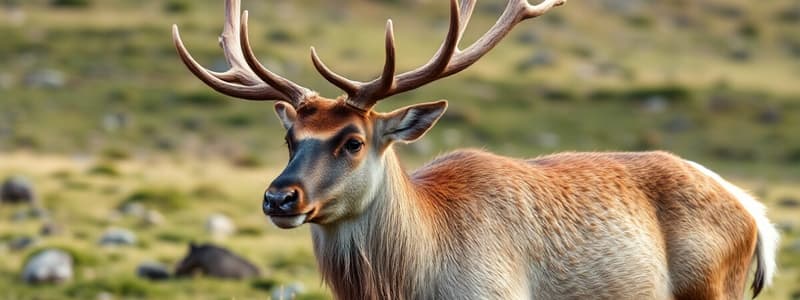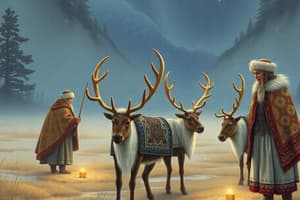Podcast
Questions and Answers
What were antlers primarily used for?
What were antlers primarily used for?
- Weapons and ornaments (correct)
- Transport and tools
- Food and beverages
- Decoration and clothing
Which part of the reindeer was used to make clothing and shoes?
Which part of the reindeer was used to make clothing and shoes?
- Fur (correct)
- Meat
- Antlers
- Bones
What was the primary use of reindeer intestines and tendons?
What was the primary use of reindeer intestines and tendons?
- Containers
- Glue and string (correct)
- Decorative crafts
- Food supply
Which of the following is NOT a use for reindeer bones?
Which of the following is NOT a use for reindeer bones?
What was the function of the reindeer stomach?
What was the function of the reindeer stomach?
What was one of the primary ways early humans coped with hunger?
What was one of the primary ways early humans coped with hunger?
Which tool is mentioned as being used by early humans?
Which tool is mentioned as being used by early humans?
What strategy did early humans employ for protection against wild animals?
What strategy did early humans employ for protection against wild animals?
How did early humans address the challenge of cold weather?
How did early humans address the challenge of cold weather?
What type of living spaces did early humans commonly use?
What type of living spaces did early humans commonly use?
What materials were primarily used for clothing by early humans?
What materials were primarily used for clothing by early humans?
What purpose did early clothing serve for humans?
What purpose did early clothing serve for humans?
What significant skill did early humans develop about 1.5 million years ago?
What significant skill did early humans develop about 1.5 million years ago?
Which of the following elements did early human art often reflect?
Which of the following elements did early human art often reflect?
What type of shelter did early humans commonly use?
What type of shelter did early humans commonly use?
Which species is known for its rudimentary language and use of fire?
Which species is known for its rudimentary language and use of fire?
What is a significant characteristic of Homo sapiens compared to earlier hominins?
What is a significant characteristic of Homo sapiens compared to earlier hominins?
Which species had the largest brain volume?
Which species had the largest brain volume?
What distinguishes Homo habilis from the other hominin species?
What distinguishes Homo habilis from the other hominin species?
Which of the following statements about Homo sapiens sapiens is true?
Which of the following statements about Homo sapiens sapiens is true?
Where do the roots of human life originate?
Where do the roots of human life originate?
What was one likely cause for early humans to leave their original habitats?
What was one likely cause for early humans to leave their original habitats?
Which species evolved from the early humans that migrated to Europe and Western Asia?
Which species evolved from the early humans that migrated to Europe and Western Asia?
What major climatic event began in Europe about two million years ago?
What major climatic event began in Europe about two million years ago?
What was the primary diet of Australopithecus?
What was the primary diet of Australopithecus?
Which species is known for being the first to use tools and fire?
Which species is known for being the first to use tools and fire?
What is one of the key survival tools that early humans developed?
What is one of the key survival tools that early humans developed?
Who was the British biologist that laid the groundwork for the theory of evolution?
Who was the British biologist that laid the groundwork for the theory of evolution?
What was a characteristic feature of Homo neanderthalensis?
What was a characteristic feature of Homo neanderthalensis?
How does the diet of Homo sapiens compare to that of Homo erectus?
How does the diet of Homo sapiens compare to that of Homo erectus?
How do all currently living humans relate in terms of species?
How do all currently living humans relate in terms of species?
What was the size range of Australopithecus?
What was the size range of Australopithecus?
What does the term 'evolution' refer to in the context of human development?
What does the term 'evolution' refer to in the context of human development?
Which species is referred to as 'Wise Man'?
Which species is referred to as 'Wise Man'?
What significant behavioral trait is noted in Neanderthals?
What significant behavioral trait is noted in Neanderthals?
Where did Homo sapiens initially inhabit?
Where did Homo sapiens initially inhabit?
What was the primary means of sustenance for people during the Paleolithic era?
What was the primary means of sustenance for people during the Paleolithic era?
What is the earliest known tool manufactured by humans during the Paleolithic period?
What is the earliest known tool manufactured by humans during the Paleolithic period?
Which of the following items would NOT have been produced from an antelope by Paleolithic hunters?
Which of the following items would NOT have been produced from an antelope by Paleolithic hunters?
What was a significant challenge faced by Paleolithic people when hunting?
What was a significant challenge faced by Paleolithic people when hunting?
How did the nomadic lifestyle of Paleolithic humans influence their settlements?
How did the nomadic lifestyle of Paleolithic humans influence their settlements?
What type of food did Paleolithic gatherers primarily seek?
What type of food did Paleolithic gatherers primarily seek?
What was one of the main reasons for the reliance on gathering as a food source in the Paleolithic era?
What was one of the main reasons for the reliance on gathering as a food source in the Paleolithic era?
Which species is NOT depicted in the diagram of human evolution?
Which species is NOT depicted in the diagram of human evolution?
What was NOT a type of tool developed during the Paleolithic period?
What was NOT a type of tool developed during the Paleolithic period?
What does the time scale on the diagram represent?
What does the time scale on the diagram represent?
Which of the following animals is NOT mentioned as prey for Paleolithic hunters?
Which of the following animals is NOT mentioned as prey for Paleolithic hunters?
What is the significance of the branches in the phylogenetic tree?
What is the significance of the branches in the phylogenetic tree?
Which skill was essential for cooperative hunting among Paleolithic humans?
Which skill was essential for cooperative hunting among Paleolithic humans?
Which hominin species appeared latest on the timeline?
Which hominin species appeared latest on the timeline?
What type of structure does the diagram of human evolution resemble?
What type of structure does the diagram of human evolution resemble?
How is the time scale measured in the diagram?
How is the time scale measured in the diagram?
Which modern primate shares a more recent common ancestor with humans according to the diagram?
Which modern primate shares a more recent common ancestor with humans according to the diagram?
What does the shaded box in the bottom-right corner most likely indicate?
What does the shaded box in the bottom-right corner most likely indicate?
Flashcards are hidden until you start studying
Study Notes
The Reindeer - Much More Than Just a Meat Provider
- The reindeer was a valuable resource for early humans, utilized for various purposes beyond its meat.
- Different parts of the reindeer were utilized for different purposes.
- Antlers were used as weapons, needles, ornaments, and decorative items.
- Meat was used as a source of food.
- Intestines and tendons were used for glue, adhesives, string, and bows.
- Fur was used for clothing, threads, shoes, and footwear.
- Bones were used for weapons, needles, ornaments, and crafts.
- The stomach was used as a container.
The Life of the Early Humans
- Early humans faced numerous challenges in their harsh environment.
- These challenges included thirst, hunger, cold, weather, wild animals, enemies, and illnesses.
- Early humans developed ingenious strategies to overcome these challenges.
- Finding water sources helped address thirst.
- Gathering berries, hunting animals, and foraging for plants provided food.
- Wearing animal skins, building fires, and creating shelters provided warmth and protection from the elements.
- Developing weapons helped them defend against wild animals and enemies.
- Using plants and berries for medicine, and performing rituals, helped them address illnesses.
On the Way to Homo Sapiens
- The document highlights various stages of human evolution, each with distinctive features.
- Homo habilis is known for its simple tool-making skills, with an estimated brain volume of 500-650 cm³.
- Homo erectus possessed more sophisticated stone tools, used fire, and had rudimentary language capabilities.
- Homo sapiens excelled in art and craftsmanship, creating complex tools and artwork. Notably, they exhibited advanced symbolic thinking and social structures.
- Homo sapiens sapiens is a recent subtype, including Neanderthals, known for their hunting capabilities and utilization of animals.
10.10 Clothing
- Humans have used clothing since approximately 35,000 BC.
- Furs and hides were the primary materials used for clothing.
- The invention of the needle was a significant advancement in clothing production.
- Different types of clothing, including underwear, cloaks, shoes, and hats, provided protection against the cold.
VT4 Hunters of the past and present
- Early humans were hunter-gatherers, relying on available natural resources.
- Similar hunter-gatherer communities exist today, like the Inuit in North America, hunters and gatherers in South Africa, and aboriginal Australians.
- Studying modern hunter-gatherers provides insight into the lifestyles of Stone Age people.
VT5 Taming Fire
- Humans migrated to Europe and Asia, needing protection from the cold.
- They learned to control fire around 1.5 million years ago.
- Initially, they protected natural fires ignited by lightning, and later learned to create fire by rubbing wood or striking flint stones.
- Fire provided warmth, light, cooking, and a deterrent for wild animals.
VT6 Housing and Clothing
- Early humans lived in huts made of branches, leaves, or animal skins, or in caves.
VT7 Art and Religion
- The creation of art and the burial of the dead emerged simultaneously.
- Early art included decorations on objects, jewelry, and famous cave paintings found worldwide.
- These paintings provide evidence of human thoughts about death, the afterlife, and symbolic expressions.
Q1 Hunters in the Kalahari, Botswana
- The image depicts people from the Kalahari region of Botswana engaged in preparing and butchering an animal using hand tools.
Waren die Menschen der Altsteinzeit Überlebenskünstler? (Were the people of the Paleolithic Era survival artists?)
- The Paleolithic Era, spanning roughly 2 million years ago to 9000 BC, was a time when humans lived as hunter-gatherers.
- This section focuses on understanding how early humans dealt with environmental challenges for survival.
Lernaufgaben (Learning Tasks)
- The text presents a series of learning tasks related to the Paleolithic Era, covering topics like hunting, gathering, and settlements.
1. Jagen (Hunting)
- The tasks explore the utilization of reindeer for food and other purposes.
- It analyzes the use of different parts of the animal, such as meat, antlers, skin, bones, tendons, and intestines.
- It investigates the specific skills and tools required for successful hunting, including the use of a hand axe.
2. Sammeln (Gathering)
- The tasks emphasize the significance of gathering resources for sustenance and compare the advantages and disadvantages of hunting versus gathering.
3. Wie siedelten die Menschen in der Altsteinzeit? (How did humans settle in the Paleolithic Era?)
- These tasks focus on understanding the Paleolithic settlements, specifically highlighting the findings at Bilzingsleben, Germany.
- The text emphasizes the importance of careful interpretation of archaeological findings to draw accurate conclusions.
Altsteinzeit (Paleolithic Era)
- The Paleolithic Era is the oldest known period of human history characterized by hunter-gatherer lifestyles and the use of stone as the primary material for tools.
VT1 Werkzeuge aus Stein (Tools Made of Stone)
- Humans started making simple stone tools around 2 million years ago.
- The hand axe was among the earliest tools, followed by the development of specialized tools for tasks like striking, scraping, drilling, and making spear tips.
- Stone remained a key material for toolmaking until later when humans learned to work with metals.
VT3 Wie ernährten sich die Menschen? (How Did Humans Obtain Food?)
- Early humans spent a significant portion of their time gathering food.
- They hunted various animals, from large game like elephants, rhinoceroses, aurochs, wild horses, and bears to smaller mammals and birds.
- However, hunting was unpredictable, so gathering fruits, berries, grains, nuts, mushrooms, honey, and insects ensured a consistent food source.
VT2 Immer unterwegs (Constantly on the Move)
- People in the Paleolithic Era were nomadic, moving in groups of 25 to 30 individuals to different locations.
- They migrated when food resources became scarce in their surrounding area.
Human Evolution in Different Periods
- This section focuses on the evolution of humans from the earliest hominids to modern humans.
D1: Europe during the last Ice Age (75,000 to 10,000 years ago)
- A map depicts the vegetation types prevalent in Europe during the last Ice Age, including tundra, steppe, and forest.
D2: The Early Man (Australopithecus)
- This section provides details about the Australopithecus species, including its characteristics, habitat, and diet.
- Australopithecus is considered the earliest human-like species, known for its ability to walk upright.
D3: The Early Human (Homo erectus)
- This section covers the features of Homo erectus, including size, habitat, diet, and characteristics.
- They were known for their tool-making skills, use of fire, and hunting practices, which played a significant role in their diet.
D4: The Neanderthal
- This section outlines the characteristics, habitat, and diet of Homo neanderthalensis, commonly known as Neanderthals.
- They were known for their robust physique, adaptation to cold climates, burial practices, and possible language abilities.
D5: The Modern Human (Homo sapiens)
- This section delves into the characteristics and evolution of Homo sapiens.
- They demonstrated advanced tool development, clothing creation, art, and social structures.
- They also possessed complex language abilities and religious or spiritual beliefs.
Wie kam der Mensch auf die Erde? (How did humans come to be on Earth?)
- This section explores the origin and spread of humans on Earth.
LernAufgabe (Learning Task)
- The text provides learning tasks focused on the human migration from Africa and their evolution.
VT1 Afrika - Wiege der Menschheit (Africa - Cradle of Humanity)
- Africa is considered the birthplace of humans, with its warm climate and abundant vegetation providing ideal conditions for human development.
- Approximately one million years ago, early humans started migrating out of Africa due to possible climate changes that impacted food availability.
VT2 Die Ausbreitung des Menschen (The Spread of Humans)
- Homo sapiens migrated from Africa more than 100,000 years ago and gradually populated different continents.
- The text suggests that Neanderthals might have been outcompeted or interbred with Homo sapiens.
VT3 Überleben in der Kälte (Survival in the Cold)
- The Ice Age, which began around 2 million years ago, had significant impacts on human survival.
- Humans used tools like clothing, fire, and shelters to adapt to the cold climates.
VT4 Die Evolution (Evolution)
- Until the 19th century, many believed in the divine creation of humans.
- However, scientific discoveries and studies have revealed that humans evolved from animal ancestors over millions of years, a concept known as evolution.
- Charles Darwin, a British biologist, played a crucial role in establishing the theory of evolution with his book "On the Origin of Species".
Human Evolution
- The image illustrates the evolutionary relationships between different hominins and primates, providing a timeline for their existence.
Diagram Description
- The diagram is a tree-like structure depicting the chronology of species evolution, with the oldest periods at the bottom and the most recent at the top.
- Various primate species, including chimpanzees, gorillas, and different human species, are represented along the timeline.
Key Features
- The diagram highlights the evolution of species over time, showing their branching relationships.
- It uses a time scale in millions of years ago (M.a.) to indicate the approximate timeframe for each species.
Examples of Species Shown
- The diagram includes various primate species, like gibbons, orangutans, gorillas, chimpanzees, Homo habilis, Homo erectus, Australopithecus, Neanderthals, and Homo sapiens.
Legend
- The legend in the bottom-right corner indicates that the shaded box represents the "Evolution of Humans".
Overall
- The diagram provides a visual representation of human evolution and the relationships between different species over millions of years.
Studying That Suits You
Use AI to generate personalized quizzes and flashcards to suit your learning preferences.





